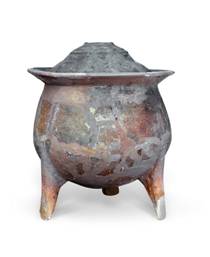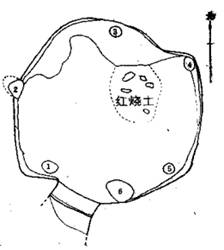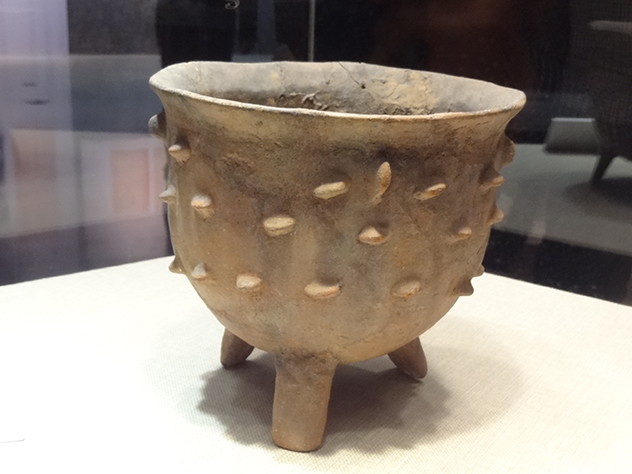
Peiligang Site
Peiligang Site, a human cultural ruin which dated back to 8000 years ago, is of great significance for the study on the Chinese prehistoric culture. It lies some 8 kilometers the west of Peiligang village, northwest of the Xinzheng city, Henan province, hence the name. The ruin covers a area of 20,000sqm, where 114 tombs, one clay kiln, over 10 ash-pits, as well as a couple of damaged foundations of the cave residence, have been excavated, totally yielding more than 400 pieces of diverse artifacts, including stone ware, pottery, bone tool, and primitive handcrafts such as clay spinning wheel, terracotta heads of pig and goat, etc. The human settlement, in the eastern half, whose cultural stratum measures 1 to 2 meters, yielded few cultural relics. The western half is a tribal graveyard. The burial pits, are rectangular in shape, with irregular edges, from which the burial objects discovered primarily fall into two categories: stone wares and potteries,
The stone wares are made by means of grinding, or chiseling followed by grinding, the typical objects include saw-shaped stone sickle, bar-shaped stone shovel with blade at either end, shoe sole-shaped stone grinder and stone rod. The potteries are universally hand-made, the typical objects includes terracotta tripod Bo bowl, crescent jar with double loop handles, tripod jar, and ding, etc. The discovery of this ruin filled in the gap of history in the early Chinese Neolithic Ages prior to the Yangshao Culture. In 1986, Henan Provincial Government listed this site as a Key Preservation Site of Cultural Heritage under the Provincial Government, and it was listed in the fifth name lists of the National Key Cultural Heritage Sites by the State Council of China on June 25th, 2001,
1. What’s the gender of the tomb occupant of tomb M5 where the Neolithic Terracotta Tripod Ding with Raised Nodes was found?
2. As a cooking vessel for steaming and boiling, what kinds of food had been boiled in this Neolithic Terracotta Tripod Ding with Raised Nodes?
Your answer please, if you have any questions or answer, please feel free to send us email, we are waiting for your answers and participation, and your comments, answers and suggestions will be highly appreciated. We will select and publicize the most appropriate answers and comments some time in the future.
Weekly Selection Email: meizhouyipin@chnmus.net
Ding cauldron was firstly produced as a cooking vessel in the Central Plains, and was deemed as the representative article of the farming civilization. Before the Chinese civilization took shape, each ethnic group had its own distinctive ethnic culture, which resulted in diverse pottery Dings with different characteristics. With an increasing exchanges between ethnic groups, and cross-pollination of cultures, the appearance and shape of Ding cauldrons showed dissimilarity and similarity. Different shapes of Ding cauldrons from each regions stood for the unique cultural feature of their own ethnic groups, and embodied the cultural character of Chinese nation with multiple ethnicities.
Red terracotta Yu vessel with stands of the Palace Museum, dated from the Cishan Culture, Neolithic Ages, measuring 20 cm in overall length, 9.5 cm in Yu’s height, 10.5 cm in mouth dia., 11.3 cm in bottom dia., 10.5 cm in stand height. With a roughly cylindrical shape, a flat bottom, and a coarse surface, the Yu vessel is made of sand-containing red terracotta, its bottom diameter is slightly larger than mouth diameter, its pedestal comprises of three boot-shaped stands. This red terracotta Yu vessel and its pedestal are likely the central part of the evolvement from three rocks serving as the stands of the terracotta pot to pottery tripod Ding with three legs.

Fig.3 Red terracotta Yu vessel with stands, in the Palace Museum
Pottery tripod Ding, made of sand-containing red clay, uncovered at Jiahu site (M420:1) of Wuyang, in 2001, measures 30 cm in mouth dia., 25.5 cm in height. With a large bowl shape, a flaring mouth, thick rim, deep belly, round bottom, the vessel is raised on three tall blade-form supports, with imprint around the exterior rim. And its upper belly is embellished with a circle of raised nodes. [7]Though sharing the same raised nodes pattern and cultural type with the Neolithic Terracotta Tripod Ding which this paper focused, this tripod Ding shows some different features.

Fig.4 Diagram of the pottery tripod Ding cauldron from Jiahu site of Peiligang Culture
Red pottery Tripod Ding with a contracted belly, unearthed at Tanghu Ruin in Xinzheng city dates from the Yangshao Culture, measures 18.50 cm in overall height, 33.50 cm in mouth diameter, in presenting Xinzheng Museum.

Fig.5 Red Pottery Tripod Ding with a Contracted Belly
Black Polished Clay Tripod Ding uncovered at Xiasi, Xichuan county, Henan province, measures 21 cm in height, 24 cm in the furthest mouth diameter, dating from the Longshan Culture in Central Plains of the Neolithic Ages, currently housed by Henan Museum. In Longshan Culture (4800-4000 years ago), tripod Ding was widely used as a cooking vessel in the middle reach of the Yellow River.

Fig. 6 Black Polished Clay Tripod Ding
Red clay Fu-shaped Tripod Ding with a cover of Dawenkou Culture which was excavated at Dawenkou, Tai’an, Shandong province, measures 28 cm in height, 13.5 cm in mouth diameter, is currently in Shandong Museum, and it dates back to 6800-4800 years ago, it is a representative vessel of the pottery tripod Dings in the lower reach of the Yellow River.

Fig.7 Red Clay Fu-shaped Tripod Ding of Dawenkou Culture with a cover
Red Clay Tripod Ding with a Cover of Qujialing Culture which was unearthed at Jinjiling, Suizhou, Hubei province, measures 33cm in height, 26.4 cm in belly diameter, is currently in the collection of Hubei Museum. Qujialing Culture dates from 6800-4800 years ago, this vessel is a representative vessel of the pottery tripod Dings in the middle reach of the Yangtze River.

Fig.8 Red Clay Tripod Ding with a Cover of Qujialing Culture
Red Clay Basin-shaped Tripod Ding of Songze Culture which was unearthed at Shanghai, measures 36 cm in height, 45 cm in mouth diameter. The rim is widely flaring outward, with a circle of visible ridge on the lower part on the belly, and a circle of saw-marked design on the middle of the body. The exterior is covered densely with concave bowstring marks. The cross-section plan of its leg is a roughly curved right-angle shape, with a wider upper part and narrow lower part in front profile, and it shows a bit flaring outward in side view. The top of the legs are impressed with two rows of vertical pitted lines. A face-shaped mark is outlined with concave line on the lower part, with a vertical saw-shaped ridge in the center, a dot on either side. On the same cultural stratum nearby the excavating site, a cooking pit beneath the tripod was found, which indicates that such a combination of tripod and cooking pit had been adopted in the lower reach of the Yangtze River.

Fig. 9 Red Clay Basin-shaped Tripod Ding of Songze Culture
Primitive farming in the Neolithic Ages provided a stable food supply for mankind, changed their food structure, and naturally leaded to the demand for pottery cooking vessels. With the development of primitive agriculture, and the demand for a stable residence, terracotta tripod ding with raised nodes, as the exclusive Chinese cooking vessel, appeared in time of Peiligang Culture.

Fig. 2 Plan of the F2 Beigang site at Ergou, Xinmi county, Henan province
(a stove site of Peiligang Culture of eight thousands years ago) [2]
Underneath the cooking vessel, enough space is required for placing wood. While most of the discovered Chinese stoves of the early Neolithic Ages were used in most cases on flat ground without building the pot stand. Whereas the tripod cauldron rested on the three legs, and facilitated the heating. The terracotta tripod ding cauldrons, with the Terracotta Tripod Ding with Raised Nodes as the typical one, stood out among the early Neolithic cooking vessels, and became the widely spread important vessel after appearance of the Peiligang Culture.
In the Bronze Age, Ding cauldron had gradually evolved into the important sacrificial and ritual vessel, and even the symbol of the state power. Until the Qin and Han era, followed the invention of conjunction of stove and Fu(pot), Ding-shaped cooking vessel faded away from then Chinese kitchen, consequently, Ding, as the cooking vessel, with a history of as long as six thousands years, came to a halt. Though beginning with being one of the household utensils, it had gradually evolved into a significant cultural sign, as well as the spiritual symbol of Chinese nation.
The Terracotta Tripod Ding with Raised Nodes, features pot clay mixed with sand to avoid cracking, skillful stacked clay coils, stable three-legged support, and rustic decoration of raised nodes, but it is an outstanding example of the terracotta Dings in the initial period of its development, indicating a great innovation and breakthrough.
In April 1977, an archaeological excavation was launched at the west Peiligang, some 7.5 Km northwest of then Xinzheng county by the local heritage authority, a batch of cultural relics, including stone wares, bone articles, potteries etc. of which, in the T2M5, discovered this Neolithic Terracotta Tripod Ding with Raised Nodes.
This vessel, measures 18 cm in height, basin-shaped, thin wall, with a slightly flared rim. Marks of stacked clay string indicate that this terracotta tripod ding was shaped by stacking the twisted clay strips to form the body of the tripod ding, followed by adding the rim by the method of pinching, and finalized with manually trimming the wall of the tripod ding to make it more elaborate.
Made of the red clay mixed with sand, Neolithic Terracotta Tripod Ding with Raised Nodes, was fired at the temperature 900—960℃, featured loose and fragile texture. The pot clay, after filtration and elutriation, contains abundant coarse gritstone which is added intentionally to make the finished product more porous and thermostable, ensuring no cracks occur while being heated repeatedly.
Under the vessel, three rectangular legs, form stable support, and facilitate adding wood to the fire underneath the tripod ding in case of cooking on the flat ground. The texture and the shape of the leg were designed for lighting the fire and for heating, which indicate that this tripod ding bears a similarity to the present day cooking pot in usage, thus it is definitely a practical boiler.

Fig.1 Detail of Neolithic Terracotta Tripod Ding with Raised Nodes
At the position of 3 to 11 centimeters under the rim are three arrays of elliptical cone-shaped nods formed with hands, of which 12 survived in lower rows, 10 remained on the top and middle rows respectively. Based on the spacing between the nods, each row should have had 14 nods initially. Due to the long age, the purpose of these nods have not been identified, but four inferred possibilities are roughly acceptable: heightening aesthetic embellishment, easily handling, strengthening the body of the vessel, increasing the heating areas. The nods of this vessel on the middle and lower rows are in horizontal array, whereas 4 nods in the top row are in vertical position, alternating with every 2 or 3 horizontal nods, displaying a apparent embellishing purpose. Thus I inferred that the raised nods are most likely for decorative purpose, if so, the raised dots pattern that exerted a far-reaching influence in Chinese history and it should have been derived from the Pailigang Culture of the early Neolithic Ages.
As one of the earliest cooking vessels, and the oldest intact pottery tripod ding known so far, this Neolithic Terracotta Tripod Ding with Raised Nodes deepens our understanding on the Peiligang Culture, offers important clues to the daily life and cultivation of the ancients of eight thousands year ago in the Central Plains, therefore it is of great significance for exploring the pottery making in the early Neolithic Ages, and for studying on the origin of the Chinese culinary culture, as well as the Ding cauldron culture.
